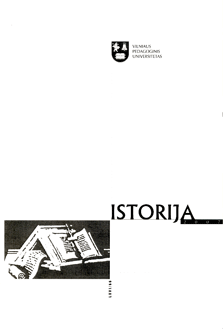Geležies amžiaus Rytų Lietuvos gyventojų demografija
Demography of the Iron Age Population in East Lithuania
Author(s): Laurynas KurilaSubject(s): History
Published by: Vytauto Didžiojo Universitetas
Summary/Abstract: The paper analyses the demography of the populations of the East Lithuanian barrowculture. The survey is based on a sample of 362 burials excavated in 64 cemeteries. Out of these, 54 were inhumations and 308 were cremations. In total, the remains of 443 individuals were identified. Due to a wide chronological and geographical distribution of the data used in the research, it presents rather a theoretical model than a demographical situation in a particular society. The obtained results and the life table of East Lithuanian populations are compared with those of well-investigated Central Lithuanian Plinkaigalis cemetery. The osteological age at death and sex determination were based on macroscopical analysis and osteometric measurement. The age at death was estimated with respect to the cranial suture closure, dental development, tooth wear and loss, epiphyseal fusion, vertebral growth and osteophyte development as well as pubic symphyseal surface. The sex of the individuals was determined mainly by the morphology of cranial and pelvic bones as well as by some long bone measurements. The available fragmentary osteological data are not sufficient for exploring matters of stature, pathology or trauma. The study is narrowed to the age and sex related issues. The individuals were divided into six age groups: up to 1 year, from 1 to 5, from 5 to 12, from 12 to 20, from 20 to 40 and over 40 years of age. Such division was employed with regard to age ranges, commonly given by the osteological analysis, and stages of human social development. The given age range for most individuals was rather wide. Therefore, the statistically evaluated presumable number of individuals in age groups was mostly used in the survey. In the graves under discussion, the number of infants up to one year of age wassurprisingly small (2.3%). In the Plinkaigalis cemetery, newborns and infants comprised 24.3% of all the population. Aconclusion can be drawn that a small number of graves reveals low social status of infants. They were probably buried in a different manner than older individuals, in different places, or not buried at all. The uncertain number of infant graves puts an obstacle in calculating the average life span. The average age of all the individuals was 27,1 years.
Journal: Istorija. Lietuvos aukštųjų mokyklų mokslo darbai
- Issue Year: 66/2007
- Issue No: 2
- Page Range: 3-11
- Page Count: 9
- Language: Lithuanian

